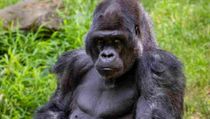Eastern Gorillas are the largest primates of the living world, comprising of muscular limbs, stocky bodies, and short muzzles. Their primary habitat is Sub-Saharan African countries such as the subalpine forests and mountain rainforests of Rwanda, southwestern Uganda, and the eastern Democratic Republic of Congo.
They are divided into subspecies - the Mountain Gorilla and the Eastern Lowland Gorilla. The Eastern Lowland Gorilla is also known as the Grauer's gorilla and has longer arms in comparison with the Mountain Gorilla.
According to the IUCN Red List, there are only about 5,000 Eastern Gorillas left in the world and are classified as Critically Endangered (CE).
Efforts to conserve these gorillas are being taken by the WWF by building national parks such as the Virunga National Park and keeping the remaining animal species in protected areas to save them from illegal poaching and diseases.
Read the article below to know more facts about Eastern Lowland Gorilla babies and Eastern Lowland Gorilla adaptations.
If you want to read more animal facts that your kids will enjoy, here are a few articles that you can check out on capuchin monkeys and proboscis monkeys.
Eastern Gorilla Interesting Facts
What type of animal is an Eastern Gorilla?
The Eastern Gorilla is the largest living primate and a critically endangered species of the gorilla subspecies. There are two Eastern Gorilla subspecies - Eastern Lowland Gorillas and Eastern Mountain Gorillas.
What class of animal does an Eastern Gorilla belong to?
The Eastern Gorilla belongs to the Mammalia class of the Animalia kingdom.
How many Eastern Gorillas are there in the world?
Eastern Gorillas are critically endangered species according to the IUCN Red List and their overall population is estimated to be somewhere around 5,000.
Where does an Eastern Gorilla live?
Eastern Gorillas are found in tropical moist forests, subalpine forests, and mountain rainforests of Sub-Saharan Africa.
What is an Eastern Gorilla's habitat?
The Eastern Gorilla's habitat includes Sub-Saharan African countries such as the subalpine forests and mountain rainforests of Rwanda, southwestern Uganda, and the eastern Democratic Republic of Congo. The Grauer gorilla inhabits forests along the Albertine Rift in the eastern Democratic Republic of Congo.
Who do Eastern Gorillas live with?
Eastern Gorillas are social creatures and they live in groups or social units called harems. The groups are often interconnected and have 35-40 members each.
How long does an Eastern Gorilla live?
Eastern Gorillas have an average lifespan of 30-60 years.
How do they reproduce?
Eastern gorillas live in family groups that are led by a silverback male. The gorillas are polygamous in nature and the adult dominant male leader has the sole right to mate with all the females of his group.
The animal species mate throughout the year and the females give birth to single baby gorillas each.
The gestation period is about eight and a half months, and the females breastfeed and take care of the young gorillas for up to three years. Females attain their sexual maturity by 10 years of age, while males take 15 years to reach sexual maturity.
What is their conservation status?
Eastern lowland gorillas are an endangered species and are at risk of extinction. Conservation efforts have taken place and national parks set up to conserve these great apes.
But illegal poaching and encroachment of their habitat continue to be the primary threat and their numbers are in constant decline. At present, there are less than 5,000 individuals and the IUCN Red List classifies eastern gorillas as Critically Endangered (CE) species.
Eastern Gorilla Fun Facts
What do Eastern Gorillas look like?

The Eastern Gorillas are the largest primates in the living world. These powerful great apes have thick chests, bluish-black or brownish-grey hair, muscular arms, and large nostrils.
Except for the hands, face, and feet, the entire bodies of these gorillas are covered with hair. The adult males are relatively bigger and weigh more than the females. They tend to have silver hair on their back and are called 'silverbacks' due to this characteristic feature.
The women are called blackbacks due to the lack of silver hair. Also, silverback males lack hair on their chests.
The Eastern Gorilla has two subspecies called the Eastern Lowland Gorilla (also known as Grauer's gorilla) and the Mountain Gorilla. Both the subspecies have short muzzles, stocky bodies, and large hands.
Their thumbs are unusually larger than their other fingers. The only point of difference is that the Mountain Gorilla has shorter arms but longer hair and teeth compared to the Grauer's gorilla.
How cute are they?
The Eastern Lowland Gorilla is a very social animal and can be quite friendly too. However, owing to their large sizes and muscular structure, they appear to be quite frightening. Baby gorillas are very cute though on the other hand.
How do they communicate?
The Eastern Lowland Gorilla communicates through vocalizations, facial expressions, and chest-thumping. There are 25 distinct vocal sounds made by the animals and each of them has different meanings.
Barks and grunts are usually made while traveling to let the group know about the whereabouts of each member. The male leader usually roars and screams to warn or discipline other members, while deep rumbling belches are signs of contentment heard during feeding or resting. The infant gorillas whimper and cry to attract their mothers.
The Eastern Lowland Gorilla also beats its chest which is mainly a sign of dominance and aggression. The animals consider staring as a sign of hostility and revealing teeth through yawning is it way of showing aggression too.
One of the most distinctive expressions displayed by the eastern lowland gorilla is the play face which constitutes of an open mouth with no bare teeth showing and low hanging lips. This expression is more than often shown by the infants and is equivalent to laughing.
How big is an Eastern Gorilla?
Eastern Gorillas are the largest primates in the world. The adult males stand at 5.6 ft (1.7m), while the female gorillas are relatively smaller and measure up to 4.9 ft (1.5 m).
How fast can an Eastern Gorilla move?
Eastern Lowland Gorillas move quadrupedally but walks on top of their knuckles instead of putting all their weights on the palms. They fold their fingers on the front two limbs and walk and this is known as knuckle-walking.
Mountain gorillas move like this most of the time, but they are also known to move bipedally too. They move very fast when they are in the forest and can run at a great speed of 20-25 mph (32.1-40.2 kph) while chasing targets.
How much does an Eastern Gorilla weigh?
Female gorillas typically weigh around 200–220 lb (90–100 kg) while a fully grown male Eastern Gorilla weighs around 309–453 lb (140–205.5 kg).
What are their male and female names of the species?
The male Eastern Lowland Gorilla is known as silverbacks in lieu of them having a silver line of fur they have on their backs after they mature. There is no specific name for the female species but are often referred to as blackbacks.
What would you call a baby Eastern Gorilla?
A baby Eastern Lowland Gorilla is known as an infant, the same as that of a human baby.
What do they eat?
Mountain gorillas are herbivores and folivores, mainly devouring bamboo, vines, roots, leaves, the pith of herbs, barks of trees, flowers, berries, stems, epithelium stripped from roots, fungi, and shrubs. They also eat small invertebrates, ants, and fruits which form a part of their diet.
Are they loud?
Mountain gorillas are very loud while communicating. Apart from loud screams, they also beat their chests rapidly with their hands to warn others of impending danger and threats.
Would they make a good pet?
No, Eastern Lowland Gorillas do not make good pets due in part to the fact that they share almost 98% of human DNA. They require a specialized diet, feeding on large quantities of vegetation, and also need their social groups to survive. Gorillas are also very large and strong, and hence impractical to keep as pets in homes.
Did you know...
The Virunga Mountains are situated at the border of the Democratic Republic of Congo and boasts of nearly more than half of the Mountain Gorilla population worldwide. This region has a national park called the Virunga National Park which is known for its Mountain Gorilla conservation.
Each gorilla has a unique noseprint that can help to identify an individual, just like human fingerprints.
Why are Eastern Gorillas endangered?
Humans pose as the most major threat to mountain gorillas. Humans poach them illegally for bushmeat, as well as encroaching their natural habitat by deforestation.
Another major reason is the reduction of genetic diversity because of the slow rate of reproduction and diseases.
As a result, these species are at risk of extinction and have been classified as Critically Endangered (CE) by the IUCN Red List. There are estimated to be only 5,000 of these animals left and their population is decreasing every day even after gorilla conservation efforts taken by World Wildlife Fund (WWF).
Different types of Gorillas
There are two species of gorillas – the Eastern Gorilla and the Western Gorilla. The latter is the more abundant species, while the Eastern Gorilla is the threatened species.
Like the eastern Gorillas, the Western Gorilla also has two subspecies - the Western Lowland Gorilla and the Cross River Gorilla.
Here at Kidadl, we have carefully created lots of interesting family-friendly animal facts for everyone to discover! Learn more about some other mammals including the Bornean orangutan and the Japanese macaque.
You can even occupy yourself at home by drawing one of our Eastern gorilla coloring pages.










